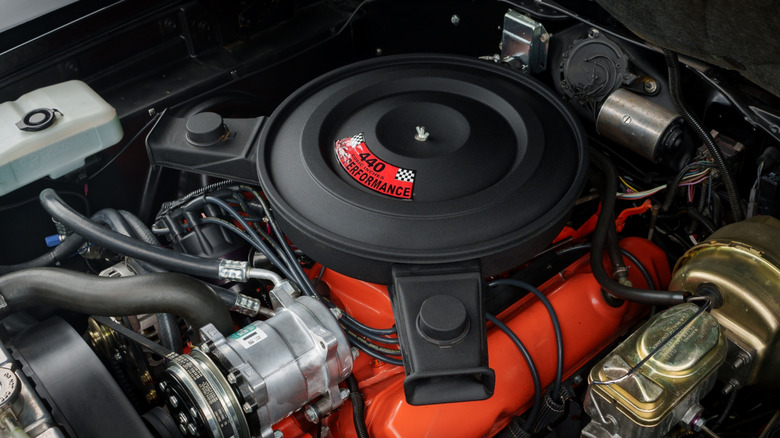Why Mopar Engines Are Painted Orange
Popping the hood on a modern car, be it performance-focused or otherwise, usually reveals nothing more than a sea of black plastic. This wasn't always the way, and if you wanted to guarantee a splash of color under the hood in decades gone by, then buying a hot Mopar product was a safe bet. Some Mopar engines from the '40s onwards could be found finished in aluminum silver, while some '60s big blocks could be found in a sharp blue-green color. However, the color most closely associated with Mopar blocks is orange.
Both race and street HEMI engines could be found finished in bright orange hues throughout the 1960s, and the color quickly became synonymous with the most powerful Mopar-branded engines of the period. This isn't just a classic thing either, as Dodge occasionally finished powerful blocks in a similar orange hue on modern engines too. Some of the fastest Hellcat-powered models – such as the Charger SRT Hellcat's 6.2-liter supercharged V8 — could be found in orange. Other Challengers, like the SRT Demon, Redeye, and Super Stock models, sported red blocks instead.
The reason why Mopar engines are sometimes painted orange, is to signify them as high-performance models. You won't find a base-model V6 Challenger with an orange block, for example. Much in the same way that Ferrari usually finishes valve covers in a bright crackle-finish red, an orange block under a Mopar model's hood is a quick way of identifying that particular car as a proper high-performance model.
Bright paint wasn't reserved just for the engines either
While orange paint is a particularly common sight on a high-performance Mopar product, this wasn't the only splash of color you'd find on a car like this. Particularly throughout the height of the muscle car era, in the 1960s and '70s, Mopar cars could regularly be found in some wild color schemes, with fun decals too. Some of our favorite classic Mopar colors include Plum Crazy, Bahama Yellow, and Panther Pink. Dodge reintroduced a number of these colors on specific models in the last decade, such as the collector-favorite Plum Crazy.
When it came to standing out in a crowd, Mopar cars wouldn't just rely on cool engine colors or bright paint schemes either. Bright and cartoonish decals would also separate these cars from competition on the road, with models like the Plymouth Roadrunner and Dodge Super Bee sporting playful imagery. Couple these with the iconic orange color used under the hood on high-performance Mopar models, and it's clear to see how the company was trying to build an exciting and instantly recognizable image for itself during what has arguably turned out to be the most influential period of American motoring.

